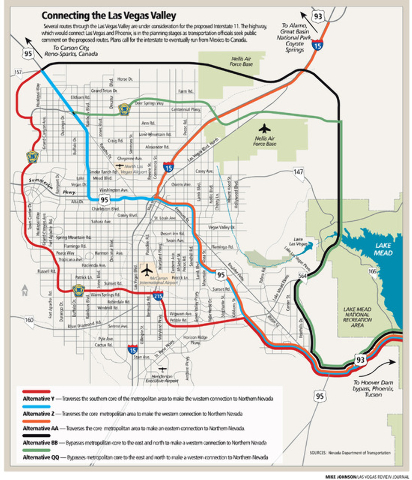A way through the valley: Public mulls Interstate 11 routes

Interstate 11, whenever it gets built, will either cut through the middle of the Las Vegas Valley, bypass town on a totally new road east of Sunrise Mountain and Nellis Air Force Base, or mostly follow the southern and western legs of the Las Vegas Beltway and hook up with U.S. Highway 95 as it heads north out of town.
These were the alternatives still in the running that state transportation officials presented to the public Thursday night.
The proposed interstate, long a hope of area officials, is still years away from becoming a reality, though. If it does happen, it would eventually connect Phoenix to Las Vegas, starting at the Mexican border and continuing all the way to Canada.
Sondra Rosenberg, the I-11 project manager for the Nevada Department of Transportation, said the region needs a north-south transportation alternative to Interstate 15 and Interstate 5 in California. For the Las Vegas area to diversify its economy, transportation is vital, she said.
“You need a really robust transportation system,” she said.
As Mexico becomes a bigger trading partner, transporting goods becomes more important. California’s freeways are already too busy to handle much more. “We think this trading activity is going to go somewhere. We’d like it to come here,” she said.
Transportation officials from Arizona and Nevada have been holding a series of public meetings this month to talk about the proposed routes the interstate would take. At a meeting earlier this week, they noted that routes that would take the freeway through eastern Nevada were no longer under consideration.
Once the road comes into Nevada from Arizona, it will use the new Hoover Dam Bypass bridge, then skirt south of Boulder City. That portion, known as the Boulder City Bypass, is already underway.
But where the road goes after that remains up in the air.
Officials originally considered almost a dozen alternative routes, including several that took the road farther south, through the largely vacant area near Jean, and back north to hook into the western leg of the beltway.
But those were eliminated for various reasons, including that they largely bypassed the Las Vegas area and raised major environmental concerns.
Five routes coming out of the Boulder City Bypass and hooking up to U.S. 95 are still in the running:
■ Connect to the beltway until deep into northwest Las Vegas, then branch off west of the Providence development and meet up with U.S. 95 north of town;
■ Stay on U.S. 95, continue through the Spaghetti Bowl, and head out of town;
■ Stay on U.S. 95, then connect to Interstate 15 and continue north;
■ Go east of Henderson and Sunrise Mountain, continue north through Lake Mead National Recreation Area, swing around the back side of Nellis Air Force Base and head west on a newly constructed road at the base of the Sheep Mountains until hooking back up with U.S. 95;
■ Take that new eastern route and swing left onto the northern leg of the 215 Beltway to U.S. 95.
Rosenberg said each of the alternative routes through Southern Nevada has pros and cons, whether they be potential cost, environmental concerns, or increasing traffic on already burdened valley roads. But they each have their advantages, too, she said.
For example, the route through town would increase traffic, but it would have little environmental impact. On the other hand, the route east of town would likely lead to less traffic through town because trucks would use it, but it could create environmental problems.
Several members of the public spoke, noting that they wished these routes were more in line with the area’s rail system.
One man, Dick Bonar, was adamant that the new route should not come through the center of town. Bonar, a longtime local who now sits on the city of Las Vegas’ Planning Commission, stressed that he was speaking as a private citizen.
Contact reporter Richard Lake at rlake@reviewjournal.com or 702-383-0307. You can find him on Twitter at @richardlake.